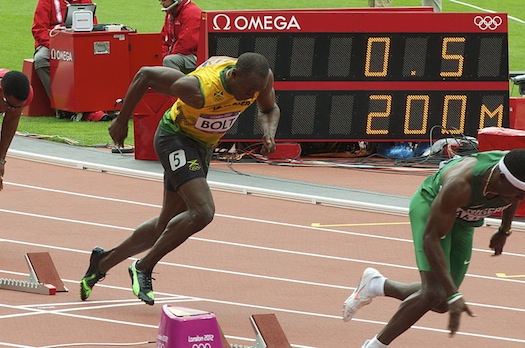

The limit to how fast a human can run is 9.48 seconds for the 100-meter race, 0.10 seconds faster than Usain Bolt’s current world record, according to Stanford biologist Mark Denny. That is, if you are talking about natural human beings.
In a 2008 study published in the Journal of Experimental Biology, Denny modeled the fastest human running speed using records of men’s 100-meter race results going back to the 1900s. Denny plotted the annual best times in the race into a graph and used computer programs to come up with an equation whose curve best models the behavior of the actual graph he obtained. The curve showed humanly achievable time for the 100-meter race would level off at 9.48 seconds. “They haven’t plateaued yet, but you can definitely see the data are bending a little towards that plateau,” Denny says.
There’s been little improvement in the Kentucky Derby since the 1950s.Denny, who also modeled the best times for racing thoroughbreds and greyhounds in the same study, found there’s a speed limit for these races as well, with little improvement in the Kentucky Derby since the 1950s and dogs’ performances leveling off in the 1970s.
“If you look at other species — ones that we’re trying to breed to run faster and faster — it’s not working,” he says. “There’s no reason to think that human beings are any different from the other species, that somehow these things don’t have limits.”
Statistical models do not explain the mechanics behind running. So Peter Weyand, a biomechanics professor at Southern Methodist University, has taken a different approach to the question.
A leading expert in human locomotion, Weyand says the primary factor influencing speed is how much force sprinters hit the ground with their feet.
When athletes run at a constant speed, they use their limbs like pogo sticks, Weyand says. Once a sprinter hits the ground, his limb compresses and gets him ready to rebound. When he’s in the air, the feet get ready to hit the ground again.
When a runner hits the ground, 90 percent of the force goes vertically to push him up again, while only 5 percent propels him horizontally. In that regard, sprinters behave a lot like a super ball, Weyand says. “What they do is they bounce a lot,” he says.
Our body naturally adjusts how fast we run by changing how hard we hit the ground. The harder we hit the ground, the faster we go.
So just how hard can humans hit the ground while they run?
In a 2010 study published in the Journal of Applied Physiology, Weyand and four other scientists had runners running on treadmills at a constant speed in different gaits –- running forward, backward, and hopping. Their study finds that when we hop, our limbs hit the ground with 30 percent more force than when we run, primarily because the foot stays much longer in the air. Based on that information, Weyand and his team calculated that in theory, human beings can run as fast as 19.3 meters per second — that is, if they hit the ground with the maximum force physiologically possible. If a sprinter were to run at that speed throughout the 100-meter race, he would finish in 5.18 seconds.
Maximizing running speed requires a tradeoff between hitting the ground hard and maintaining stride frequency.But that’s not the end of the story. In a new study to be published this year, Weyand and his team have found that maximizing running speed requires a tradeoff between hitting the ground hard and maintaining stride frequency. Hitting the ground with maximum force requires the sprinter to spend more time in the air, which slows down the strides he can make per second. The optimal combination of stride frequency and ground force varies with individuals depending on their size, leg length, and the speed they run, Weyand says. There is no golden ratio.
So what’s the fastest human running speed possible under this new model? Weyand is reluctant to give a definite number. “Science is not good at making predictions of extremes,” he says.
Nonetheless, he says he wouldn’t take 9 seconds for men’s 100-meter race off the table. “Something in the low 9s is definitely possible, perhaps faster,” he says.
That speed still won’t allow us to outrun an adult cheetah, the fastest land mammal, which can cover 100 meters in less than 6 seconds.
Science and technology are changing the limits to human running speed.Science and technology are changing the limits to human running speed. Athletes nowadays can take hormone doses to change the mechanical properties of muscles, and scientists have succeeded in tweaking mice’s DNAs to alter their muscle fibers.
“We’re sort of moving into a Brave New World in athletics where there are many many different types of performance enhancement avenues available,” Weyand says. “What’s happening is that identifying what’s natural and what’s not natural is becoming increasingly blurry. To me, (to answer) what’s the ultimate speed somebody can run, we now have to go through a list of 10 different conditions: are we talking about no gene doping, no special technology, no pharmaceutical agents … But as we go further and further along there’s even potential for tracking shoe design to change speed. It starts to become a horribly complicated question.”
This story was produced in partnership with Northwestern University’s Medill School of Journalism. For more FYIs, go here.
